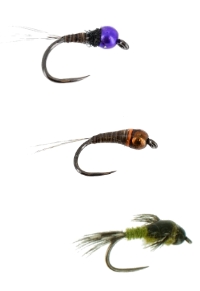Madison
Located in Southwestern Montana, the Madison River is a favorite among fly anglers. It is known as the "fifty mile riffle". It gets this nickname because the water between Quake Lake and Ennis lake never seems to change. You will not find any slow, deep, pools, any boulders, fallen trees, or tumbling runs. What you will find is a river characteristic of a long giant riffle. There are no boulders to break currents or changes in the gradient to slow it enough to create a pool. You may ask yourself, why in the world would I want to fiah a river with no character? Well, for one, the river flows at a nice steady pace, making it easier for beginners to catch fish. The trout here do not get the chance to examine your fly, and a more enticed to eat simply out of reaction. The river is also very accessible, easy to wade, and very easy to drift. It also has an excellent and diverse population of large trout including rainbows, browns, cutthroat and cutt-bows as well.
The headwaters of the Madison start above Hebgen Lake and consist of the Firehole and Gibbon which, in their own right, are fantastic trout streams. They come together to form the Madison which eventually flows into Hebgen Lake. The upper stretch of the Madison has slower moving, dry fly type of pools, that are a favorite among wade fisherman. It also gets runs of spawning trout that migrate up it each year from Hebgen Lake. The rainbows spawn in the spring, while the browns spawn in the fall. These trout can reach weights of seven pounds or more. Hebgen Lake is also a very productive and famous piece of water consisting of large rainbows and browns. Many people fish the lake from boats and float tubes when conditions are right, and the wind isn't creating Pacific Ocean type waves on it. Large woolly buggers and Trophy Streamers are a productive flies on the lake. The Madison leaves Hebgen Lake and flows down into Quake Lake. Quake Lake was created by an earthquake back in 1959, hence the name.
Just below Quake Lake, the Madison starts its famous journey down to Ennis Lake, which is approximately 50 miles to the north. This section of river is what's known as the acclaimed "50 mile riffle." This is a world famous stretch of river runs cold throughout the year due to the water releases from the dam at Hebgen Lake. The riverbed here consists of gravel and small stones, which makes it the perfect habitat for large rainbows and brown trout. It's also makes for perfect spawning habitat for them as well, and thus the population of fish in this area is extremely dense. Route 287 and other secondary dirt and gravel roads provide several access points along the Madison all the way to the Town of Ennis and Ennis lake.
The Madison then makes another 30 mile journey below Ennis Lake until it meets with the Gallatin and Jefferson to form the Missouri River. This stretch of river is similar to the section above Ennis Lake, except it is warmer and has some dangerous water flowing through the Bear Trap Canyon stretch. The river flattens out below Bear Trap and slows down before entering the town of Three Forks. This is where it meets the Gallatin and Jefferson Rivers. Monster browns make up most of the trout population below Ennis Lake. Large beadheaded nymphs, bounced along the bottom in the Bear Trap Canyon stretch, can produce some trophy fish. In particular, 2 Bead Stoneflies in black are a must have for this section.
Hatches on the Madison consist of Black and Tan Caddis, Salmon Flies(big stones), Yellow Sallies, and a few mayflies like the Blue-winged Olive's and PMD's. Hoppers, Ants and Beetles are also important to have in late summer and early fall. Big streamers, and a variety of nymphs are also a staple throughout the season.



